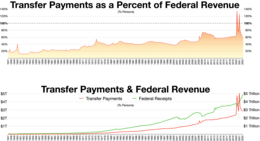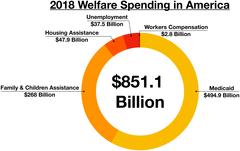
Back Sozialversicherung (Vereinigte Staaten) German برنامههای اجتماعی در ایالات متحده آمریکا Persian Stato sociale negli Stati Uniti d'America Italian Social programs in the United States SIMPLE Socialpolitik i USA Swedish

| This article is part of a series on the |
| Economy of the United States |
|---|
 |


In the United States, the federal and state social programs including cash assistance, health insurance, food assistance, housing subsidies, energy and utilities subsidies, and education and childcare assistance. Similar benefits are sometimes provided by the private sector either through policy mandates or on a voluntary basis. Employer-sponsored health insurance is an example of this.
American social programs vary in eligibility with some, such as public education, available to all while others, such as housing subsidies, are available only to a subsegment of the population. Programs are provided by various organizations on a federal, state, local, and private level. They help to provide basic needs such as food, shelter, education, and healthcare to residents of the U.S. through primary and secondary education, subsidies of higher education, unemployment and disability insurance, subsidies for eligible low-wage workers, subsidies for housing, Supplemental Nutrition Assistance Program benefits, pensions, and health insurance programs. Social Security, Medicare, Medicaid, and the Children's Health Insurance Program are prominent social programs.
Research shows that U.S. government programs that focus on improving the health and educational outcomes of low-income children are the most effective, with benefits substantial enough that the government may even recoup its investment over time due to increased tax revenue from adults who were beneficiaries as children.[2][3] Veto points in the U.S. structure of government make social programs in the United States resilient to fundamental change.[4][5]
- ^ STANLEY , D. (2023). The Conscience of a Liberal. New York: W. W. Norton
- ^ Hendren, Nathaniel; Sprung-Keyser, Ben (2020). "A Unified Welfare Analysis of Government Policies". The Quarterly Journal of Economics. 135 (3): 1209–1318. doi:10.1093/qje/qjaa006.
- ^ García, Jorge Luis; Heckman, James J.; Leaf, Duncan Ermini; Prados, María José (2019). "Quantifying the Life-Cycle Benefits of an Influential Early-Childhood Program". Journal of Political Economy. 128 (7): 2502–2541. doi:10.1086/705718. ISSN 0022-3808. PMC 7331936. PMID 32616965.
- ^ Hacker, Jacob (2005). "Policy Drift: The Hidden Politics of US Welfare State Retrenchment". Beyond Continuity: Institutional Change in Advanced Political Economies. Oxford University Press.
- ^ Pierson, Paul (1994). Dismantling the Welfare State?: Reagan, Thatcher and the Politics of Retrenchment. Cambridge Core. doi:10.1017/cbo9780511805288. ISBN 9780521403825. Retrieved March 20, 2020.